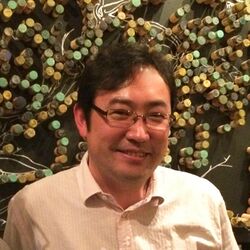Yasunori Nomura
Topic: Biography
 From HandWiki - Reading time: 2 min
From HandWiki - Reading time: 2 min
Yasunori Nomura | |
|---|---|
 Berkeley physicist Yasunori Nomura, January 7, 2016 | |
| Born | January 21, 1974 Kanagawa, Japan |
| Nationality | Japan ese |
| Alma mater | University of Tokyo |
| Known for | Orbifold GUTs Holographic Higgs Multiverse is the same as quantum many worlds |
| Scientific career | |
| Institutions | University of California, Berkeley |
Yasunori Nomura (born 1974) is a theoretical physicist working on particle physics, quantum gravity, and cosmology. He is a professor of physics at University of California, Berkeley, a senior faculty scientist at Lawrence Berkeley National Laboratory, and a principal investigator at Kavli Institute for the Physics and Mathematics of the Universe. Since 2015, he has been the director of the Berkeley Center for Theoretical Physics.[1]
Career
Nomura received his Ph.D. from University of Tokyo (supervisor Tsutomu Yanagida) in 2000 and became a Miller Research Fellow at University of California, Berkeley. In 2002-03 he was an associate scientist at Fermi National Accelerator Laboratory. In July 2003 he joined the Department of Physics at University of California, Berkeley. In 2017, Nomura was elected a Fellow of the American Physical Society "for pioneering contributions to a variety of areas of particle theory, including gauge unification in extra dimensions, electroweak symmetry breaking, supersymmetric models, dark matter, the multiverse, foundations of quantum mechanics, and black holes."[2][3]
Work
Nomura works on particle physics, quantum gravity, and cosmology. He developed theories of grand unification in higher dimensional spacetime[4] and constructed the so-called holographic Higgs model, the first realistic model in which a composite Higgs particle arises as a pseudo-Nambu–Goldstone boson.[5] He also proposed that the eternally inflating multiverse is the same thing as quantum many worlds.[6][7]
References
- ↑ http://bctp.berkeley.edu/index.html
- ↑ APS Fellows 2017(in English)
- ↑ Yasunori Nomura named new American Physical Society Fellow
- ↑ Hall, L.J.; Nomura, Y. (2003). "Grand unification in higher dimensions". Annals of Physics 306: 132. doi:10.1016/S0003-4916(03)00077-0. Bibcode: 2003AnPhy.306..132H.
- ↑ Contino, R.; Nomura, Y.; Pomarol, A. (2003). "Higgs as a holographic pseudo-Goldstone boson". Nuclear Physics B671: 148. doi:10.1016/j.nuclphysb.2003.08.027. Bibcode: 2003NuPhB.671..148C.
- ↑ Nomura, Y. (2011). "Physical theories, eternal inflation, and the quantum universe". Journal of High Energy Physics 11: 063. doi:10.1007/JHEP11(2011)063. Bibcode: 2011JHEP...11..063N.
- ↑ http://blogs.discovermagazine.com/cosmicvariance/2011/05/26/are-many-worlds-and-the-multiverse-the-same-idea/#.VWtNSB29Dak
External links
 KSF
KSF